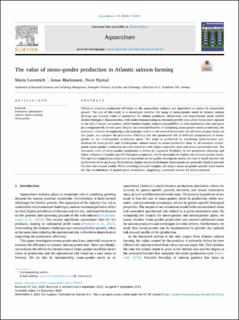| dc.contributor.author | Lavrutich, Maria | |
| dc.contributor.author | Markussen, Jonas Drageland | |
| dc.contributor.author | Rystad, Nore | |
| dc.date.accessioned | 2024-01-03T12:56:12Z | |
| dc.date.available | 2024-01-03T12:56:12Z | |
| dc.date.created | 2023-09-18T09:47:52Z | |
| dc.date.issued | 2024 | |
| dc.identifier.issn | 0044-8486 | |
| dc.identifier.uri | https://hdl.handle.net/11250/3109563 | |
| dc.description.abstract | Efforts to enhance production efficiency in the aquaculture industry are imperative to ensure its sustainable growth. The aim of this study is to investigate whether the usage of mono-gender smolt in Atlantic salmon farming can increase value of operations for salmon producers. Mono-male and mono-female smolt exhibit distinct biological characteristics, with males demonstrating accelerated growth rates, albeit being more exposed to the risk of sexual maturation, while females display reduced susceptibility to such maturation risks and grow at a comparatively slower pace. Despite the potential benefits of optimizing mono-gender smolt production, the economic viability of employing such strategies within a risk-reward framework has not been studied before In this paper, we compare the production efficiency and the operational risk of different compositions of mono-gender to the mixed-gender production plans. The study is performed by simulating multi-location productions of mono-gender and mixed-gender salmon based on actual production data. In all scenarios investigated, mono-gender production provides solutions with higher expected value and lower operational risk. The increased value of mono-gender production is driven by improved flexibility in the production planning and better utilisation of gender-specific biological properties, which outweighs the higher cost of mono-gender smolt. The optimal composition of genders is dependent on the quality downgrade factor, the cost of smolt and the risk preferences of the producer. Nevertheless, higher shares of all-female deployments are generally found to provide the best risk/reward profile. While providing valuable insights, the study's focus on gender-specific traits leaves out the consideration of market price uncertainty, suggesting a potential avenue for future research. | en_US |
| dc.language.iso | eng | en_US |
| dc.publisher | Elsevier B. V. | en_US |
| dc.rights | Navngivelse 4.0 Internasjonal | * |
| dc.rights.uri | http://creativecommons.org/licenses/by/4.0/deed.no | * |
| dc.title | The value of mono-gender production in Atlantic salmon farming | en_US |
| dc.title.alternative | The value of mono-gender production in Atlantic salmon farming | en_US |
| dc.type | Peer reviewed | en_US |
| dc.type | Journal article | en_US |
| dc.description.version | publishedVersion | en_US |
| dc.source.volume | 578 | en_US |
| dc.source.journal | Aquaculture | en_US |
| dc.identifier.doi | 10.1016/j.aquaculture.2023.740089 | |
| dc.identifier.cristin | 2175900 | |
| dc.source.articlenumber | 740089 | en_US |
| cristin.ispublished | true | |
| cristin.fulltext | original | |
| cristin.qualitycode | 2 | |

